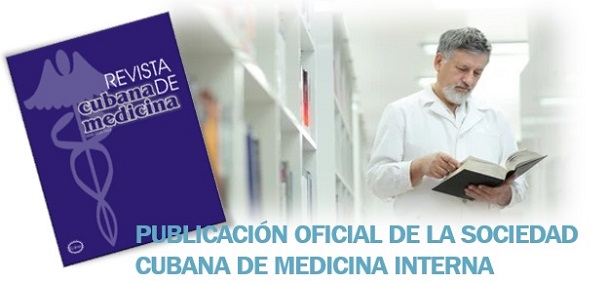Resumen: La hipertensión arterial es uno de los problemas de salud en nuestro país y de la medicina contemporánea, causante de infartos de miocardio, accidentes cerebrovasculares y alteraciones de la retina. Objetivo: describir los cambios del sistema vascular de la retina en pacientes con hipertensión arterial esencial leve y moderada a través de las alteraciones en el fondo del ojo, la respuesta de los tests electrofisiológicos y el comportamiento de la dinámica circulatoria por angiografía. Leer más…
Resumen: Se examina si los polimorfismos rs180070 y rs2070011 del gen del fibrinógeno podrían afectar al riesgo de enfermedad coronaria de los pacientes hipertensos al modificar el proceso inflamatorio y la coagulación. Métodos. Se practicó una angiografía coronaria a causa de síntomas de angina estable a 744 participantes, de los que 332 tenían hipertensión. Leer más…
. En: Artículos recomendados ![]()
Resumen: La alimentación saludable constituye uno de los principales factores de promoción y mantenimiento de una buena salud durante toda la vida. La dieta inadecuada es uno de los principales factores de riesgo de aparición de las principales enfermedades no transmisibles (ENT), como las cardiovasculares, el cáncer o la diabetes mellitus. La investigación epidemiológica ha demostrado una estrecha relación entre la alimentación y el riesgo para desarrollar ENT, caracterizada por una elevada morbilidad y mortalidad, por lo que es necesario establecer normas de referencia que sirvan de guía para garantizar un estado nutricional adecuado. El modelo de una alimentación saludable contribuye a un excelente estado nutricional y a una mejor calidad de vida en las personas. Se revisan algunos de los estudios más sólidos y recientes que abordan esta temática.
Citado: Mariño García A, Núñez Velázquez M, Gámez Bernal AI. Alimentación saludable. Acta Médica [Internet]. 2016 [citado 6 Nov 2017];17(1).
. En: Artículos recomendados ![]()
Resumen: Los nuevos estilos de vida han provocado el abandono de determinados hábitos saludables de alimentación. Es en este contexto donde han surgido los alimentos funcionales como aquellos que proveen beneficios a la salud. Actualmente se da gran importancia a la utilización de los alimentos funcionales para corregir las posibles “disfunciones o alteraciones de la microbiota intestinal, mediante la utilización de agentes bioterapéuticos (prebióticos, probióticos y simbióticos), que han sido catalogados como productos nutracéuticos; es decir, de origen natural, beneficiosos para la salud, con propiedades biológicas activas y capacidad preventiva y/o terapéutica definida. Se revisan algunos de los estudios más sólidos y recientes que abordan esta temática.
Citado: Mariño García A, Núñez Velázquez M, Barreto Penié J. Microbiota, probióticos, prebióticos y simbióticos. Acta Médica [Internet]. 2016 [citado 6 Nov 2017];17(1).
. En: Artículos recomendados ![]()
Clinical trialists generally accept the premise that surprising results in subgroups of a randomized, controlled trial most likely arise from chance. As we wrote nearly three decades ago, “We believe that the overall ‘average’ result of a randomized clinical trial is usually a more reliable estimate of treatment effect in the various subgroups examined than are the observed effects in individual subgroups.” When we wrote those words, trials involving patients with genetic markers or specific biologic targets were uncommon. Today, subgroups that are defined by such targets are, and we believe should be, analyzed with the view to making specific inferences about effects that may be unique to that group. Similarly, few trials in the 1980s were multinational; today many are. This article addresses the question of interpretation of observed variation in treatment effect among subgroups that are defined by country or geographic region. We do not address variability in observed effects according to the individual trial site, because in most multicenter trials, the sample size at each site is too small to expect reliable estimates of treatment effect.
Citado: Yusuf S, Wittes J. Interpreting Geographic Variations in Results of Randomized, Controlled Trials. N Engl J Med [Internet]. 2016 [citado 7 Nov 2017];375(23).
. En: Artículos recomendados ![]()
Abstract: Both genetic and lifestyle factors contribute to individual-level risk of coronary artery disease. The extent to which increased genetic risk can be offset by a healthy lifestyle is unknown. METHODS: Using a polygenic score of DNA sequence polymorphisms, we quantified genetic risk for coronary artery disease in three prospective cohorts – 7814 participants in the Atherosclerosis Risk in Communities (ARIC) study, 21,222 in the Women’s Genome Health Study (WGHS), and 22,389 in the Malmö Diet and Cancer Study (MDCS) – and in 4260 participants in the cross-sectional BioImage Study for whom genotype and covariate data were available. We also determined adherence to a healthy lifestyle among the participants using a scoring system consisting of four factors: no current smoking, no obesity, regular physical activity, and a healthy diet. Leer más…
. En: Artículos recomendados ![]()
Resumen: La «presentación de casos» (case-report) ha sido una tradición en medicina clínica de larga data, así como una de las vías más motivantes de compartir experiencias con otros colegas y para transmitir conocimientos y habilidades a los educandos. A ello se unen los beneficios inmediatos que representan para la atención médica con calidad de los enfermos, que contribuyen a mejorar las relaciones humanas y profesionales y despiertan un sentimiento de satisfacción en los que participan, pues se intercambian informaciones, opiniones, experiencias y sugerencias siempre muy gratificantes. Sin embargo, en las últimas décadas, la moda de las actualizaciones, las revisiones sistemáticas, los temas relacionados con la medicina basada en la evidencia, las guías de práctica clínica, los protocolos y los resultados de diversos tipos de investigaciones en el campo de la clínica llevadas a cabo con diseños complejos y la aplicación de métodos estadísticos complicados -todos asuntos de interés y que se deben tener en cuenta-, han venido a ocupar buena parte del espacio que antes se dedicaba a las presentaciones de casos en diversas revistas médicas. Leer más…
. En: Artículos recomendados ![]()
A 63-year-old woman presents with a 1-year history of a chronic dry cough, associated with a sensation of “irritation” in the throat. Prolonged bouts of coughing are associated with stress urinary incontinence and occasionally end with retching and vomiting. The cough is triggered by changes in temperature, strong smells (e.g., the smell of cleaning products), laughing, and prolonged talking. She has no notable medical history, reports being otherwise well, and does not smoke. She has been prescribed a bronchodilator and inhaled and nasal glucocorticoids, but has had no benefit from any of these. The results of a physical examination, chest radiography, and spirometry are normal. How would you further evaluate and manage this condition?
Citado: Smith JA, Woodcock A. Chronic Cough. N Engl J Med [Internet]. 2016 [citado 7 Nov 2017];375(16).
. En: Artículos recomendados ![]()
The incidence of cholangiocarcinoma in the general population is low; nevertheless, patients with primary sclerosing cholangitis face a lifetime risk of cholangiocarcinoma that is as high as 10%.1 Lazaridis and LaRusso (Sept. 22 issue)2 suggest the use of endoscopic retrograde cholangiopancreatography (ERCP)–guided cytobrushing of the bile duct for cytologic and fluorescence in-situ hybridization (FISH) analysis when strictures in the biliary system predominate, since in these cases the exclusion of cancer is mandatory but can be extremely challenging when noninvasive radiologic imaging is used. Both cytologic analysis and FISH have dismal positive and negative predictive values — 50% and 83%, respectively, for cytologic analysis and 86% and 88% for FISH.3. The use of new endoscopic techniques, such as ERCP-guided single-operator peroral cholangioscopy (SOPC) and probe-based confocal laser endomicroscopy (pCLE), may increase the positive predictive value (to 100% and 82%, respectively) and the negative predictive value (to 95% and 100%) in affected patients with indeterminate dominant strictures. Leer más…
. En: Artículos recomendados ![]()
Randomized clinical trials serve as the standard for clinical research and have contributed immensely to advances in patient care. Nevertheless, several shortcomings of randomized clinical trials have been noted, including the need for a large sample size and long study duration, the lack of power to evaluate efficacy overall or in important subgroups, and cost. These and other limitations have been widely acknowledged as limiting medical innovation.1 Adaptive trial design has been proposed as a means to increase the efficiency of randomized clinical trials, potentially benefiting trial participants and future patients while reducing costs and enhancing the likelihood of finding a true benefit, if one exists, of the therapy being studied.
Citado: Bhatt DL, Mehta C. Adaptive Designs for Clinical Trials. N Engl J Med [Internet]. 2016 [citado 7 Nov 2017];375(1).
. En: Artículos recomendados ![]()



















DE NUESTROS LECTORES